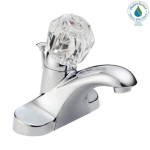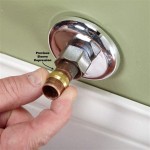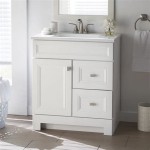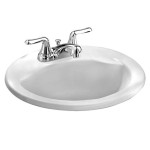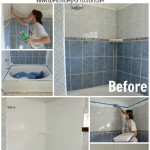How to Connect a Bathroom Sink Drain Pipe to the Wall
Connecting a bathroom sink drain pipe to the wall is a common plumbing task that, while seemingly straightforward, requires careful attention to detail and understanding of basic plumbing principles. A properly connected drain system is crucial for preventing leaks, ensuring efficient wastewater removal, and maintaining a sanitary bathroom environment. This article provides a comprehensive guide on how to connect a bathroom sink drain pipe to the wall, covering the necessary materials, tools, step-by-step instructions, and essential considerations for a successful installation.
The bathroom sink drain assembly is comprised of several interconnected components. The sink drain itself, often referred to as the strainer or basket strainer, is the uppermost part that sits within the sink basin. Below the sink, the drain connects to the tailpiece, a vertical pipe that extends downwards. The tailpiece then connects to the P-trap, a crucial component designed to trap debris and prevent sewer gases from entering the bathroom. Finally, the P-trap connects to the drain pipe that extends into the wall, leading to the main plumbing system. The focus of this article is on the connection between the P-trap and the drain pipe within the wall.
Properly connecting these components is essential for preventing leaks and ensuring wastewater flows correctly. A poorly connected drain can lead to water damage, unpleasant odors, and costly repairs. Therefore, it is imperative to understand the steps involved and take necessary precautions to ensure a secure and watertight connection.
Key Point 1: Gathering the Necessary Materials and Tools
Before commencing any plumbing work, it is crucial to gather all the necessary materials and tools. Having these readily available will streamline the process and prevent unnecessary delays. The specific materials required may vary slightly depending on the existing plumbing configuration and the type of connections being made. Here's a comprehensive list of essential materials and tools:
Materials:
- P-Trap: A new P-trap assembly, if the existing one is damaged or needs replacement. Ensure the P-trap is compatible with the drain pipe size. P-traps are typically made of PVC or metal (brass or chrome).
- Drain Pipe Extension (if needed): A section of PVC or metal pipe to extend the drain pipe coming out of the wall if it is too short or improperly positioned.
- Thread Seal Tape (Teflon Tape): Used to create a watertight seal on threaded connections.
- PVC Primer and Cement (if using PVC): Used to bond PVC pipes and fittings together. Ensure you use primer before applying cement for a strong and secure joint.
- Slip Joint Washers: Replacement washers for slip joint connections in the drain assembly. These are often made of rubber or plastic.
- Clean Rags or Towels: For cleaning up spills and wiping down surfaces.
Tools:
- Pipe Wrench or Adjustable Wrench: For tightening and loosening pipe fittings.
- Channel-Lock Pliers: For gripping and turning pipes and fittings.
- Hacksaw or Pipe Cutter: For cutting PVC or metal pipes to the desired length.
- Utility Knife: For trimming excess thread seal tape.
- Measuring Tape: For accurately measuring pipe lengths.
- Level: To ensure the drain pipe has a slight downward slope for proper drainage.
- Safety Glasses: To protect your eyes from debris and chemicals.
- Gloves: To protect your hands from dirt, grime, and chemicals.
- Bucket or Container: To catch any water that may drain from the pipes.
Having all these materials and tools ready will significantly expedite the process and minimize the chances of encountering unexpected problems during the installation. Proper preparation is key to a successful outcome.
Key Point 2: Step-by-Step Instructions for Connecting the Drain Pipe
The following provides a detailed, step-by-step guide on how to connect the bathroom sink drain pipe to the wall:
Step 1: Preparation and Safety Before beginning, turn off the water supply to the sink. This is typically done by closing the shut-off valves located under the sink. Place a bucket or container under the existing drain assembly to catch any residual water. Wear safety glasses and gloves to protect yourself. Carefully remove the old P-trap and drain pipe connection from the wall's drain pipe. Inspect the drain pipe protruding from the wall for any damage or corrosion. Clean the pipe thoroughly to ensure a clean surface for the new connection.
Step 2: Assessing the Existing Plumbing Carefully examine the existing plumbing configuration. Determine the size and type of the drain pipe extending from the wall. Is it PVC, copper, or another material? Measure the distance between the tailpiece of the sink drain and the drain pipe in the wall. This measurement will determine the length of any necessary extension pipes or fittings. Note the type of connection used previously. Was it a threaded connection, a slip joint, or a glued PVC joint?
Step 3: Preparing the Drain Pipe Extension (If Needed) If the drain pipe extending from the wall is too short or improperly positioned, an extension may be required. Measure and cut a section of PVC or metal pipe to the correct length. If using PVC, apply PVC primer to both the inside of the fitting and the outside of the pipe. Then, apply PVC cement to both surfaces and quickly insert the pipe into the fitting. Hold the joint firmly together for a few seconds until the cement sets. Ensure the extension pipe is clean and free of any burrs or debris. If using metal pipe, clean and deburr the cut end.
Step 4: Connecting the P-Trap Attach the P-trap to the tailpiece of the sink drain. Use slip joint washers to create a watertight seal. Ensure the washers are properly seated and tightened by hand initially, then use an adjustable wrench to tighten further, being careful not to overtighten and damage the plastic. Align the P-trap with the drain pipe extending from the wall. If necessary, adjust the position of the P-trap or the drain pipe extension to ensure a proper fit.
Step 5: Making the Final Connection Depending on the type of connection, either thread or slip the P-trap into the drain pipe extending from the wall. For threaded connections, apply thread seal tape (Teflon tape) to the threads of the drain pipe. Wrap the tape clockwise around the threads several times. Carefully screw the P-trap onto the drain pipe, tightening it firmly with an adjustable wrench. For slip joint connections, ensure the slip joint washer is properly seated and tighten the slip joint nut by hand, then use an adjustable wrench to tighten further. Again, be careful not to overtighten. Ensure there is a slight downward slope from the P-trap towards the drain pipe in the wall to facilitate proper drainage. Use a level to check the slope.
Step 6: Testing for Leaks After completing the connection, turn the water supply back on slowly. Carefully inspect all connections for any leaks. Run the water in the sink for several minutes and observe the drain assembly for any signs of drips or leaks. If leaks are detected, tighten the connections slightly. If leaks persist, disassemble the connection, inspect the washers and threads, and reassemble with fresh thread seal tape or new washers if necessary.
Key Point 3: Important Considerations and Best Practices
Connecting a bathroom sink drain pipe to the wall is not always a simple task, and there are several important considerations and best practices to keep in mind to ensure a successful and long-lasting installation.
Material Compatibility: Ensure the materials used for the drainpipe and P-trap are compatible. Mixing different types of metals, such as copper and galvanized steel, can lead to corrosion and leaks. If transitioning between different materials, use appropriate transition fittings designed for that purpose. PVC should only be joined with PVC. Consider using the same material as the existing plumbing for ease of connection and compatibility.
Proper Support: Long runs of drain pipe should be properly supported to prevent sagging and stress on the connections. Use pipe hangers or straps to secure the drain pipe to the wall or floor joists. This will help maintain the proper slope and prevent leaks caused by excessive weight on the connections.
Avoiding Overtightening: Overtightening connections, especially plastic slip joints, can easily damage the fittings and lead to leaks. Tighten connections snugly, but avoid applying excessive force. Hand-tighten slip joint nuts first, then use an adjustable wrench to tighten slightly further. Metal threaded connections can be tightened more firmly, but be careful not to strip the threads.
Proper Slope: Maintaining a slight downward slope in the drain pipe is crucial for ensuring proper drainage. A slope of approximately 1/4 inch per foot is generally recommended. This allows wastewater to flow freely and prevents clogs from forming. Use a level to check the slope and adjust the pipe accordingly.
Addressing Clogs: Before making any connections, inspect the drain pipe extending from the wall for any signs of clogs or blockages. If a clog is suspected, use a drain snake or auger to clear the blockage. This will prevent future problems and ensure the drain system functions properly. Consider also cleaning the P-trap if it's being reused, as debris can accumulate there over time.
Local Plumbing Codes: Be aware of local plumbing codes and regulations. Some jurisdictions may have specific requirements for drain pipe materials, installation methods, and venting. Check with the local building department to ensure compliance with all applicable codes.
Professional Assistance: If unsure about any aspect of the installation, or if the plumbing system is complex or significantly damaged, consider seeking professional assistance from a qualified plumber. Attempting to perform plumbing work without the necessary knowledge and experience can lead to costly mistakes and potential safety hazards.
By following these guidelines and taking necessary precautions, connecting a bathroom sink drain pipe to the wall can be a manageable task for many homeowners. However, prioritizing safety, understanding the principles involved, and seeking professional help when needed are crucial for ensuring a successful and long-lasting installation. Regular inspection and maintenance of the drain system can help prevent future problems and maintain a functional and sanitary bathroom environment.

How To Install Bathroom Sink Plumbing Set Up Your Own Oatey

How To Connect A Bathroom Sink Drain

How To Install A Bathroom Sink Drain 4 Steps With Pictures Instructables

Plumbing How Do I Connect My Sink To The Drain In Wall Home Improvement Stack Exchange

How To Install Bathroom Sink Plumbing Set Up Your Own Oatey

How To Install A Pipe From Sink Drain Wall Ehow

How To Plumb A Drain Sink Pipes

Plumbing How Do I Connect My Sink To The Drain In Wall Home Improvement Stack Exchange

Bathroom Sink Plumbing Installation

How To Connect A Bathroom Sink Drain
Related Posts
